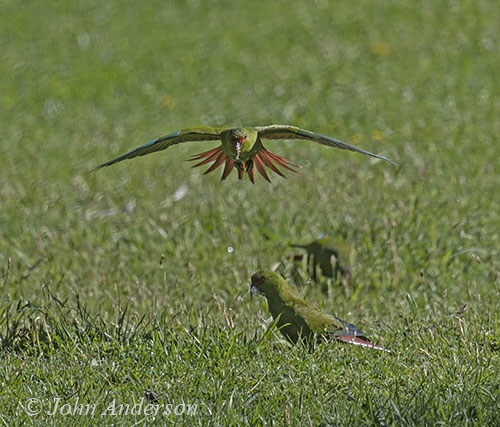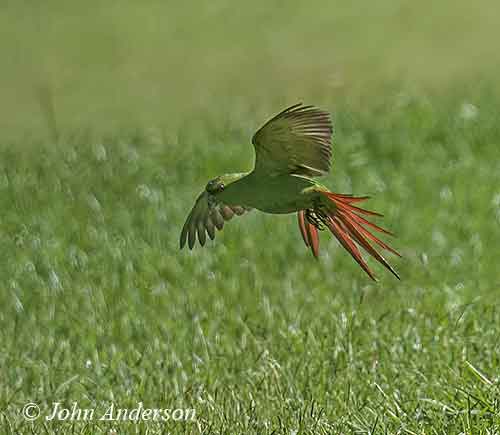
Some observations allowed to describe the breeding habitat of the Slender-billed Parakeet. The species uses scattered, remnant fragments of old-grown Nothofagus forests found in the lowland agricultural landscapes of Southern Chile, involving conflicts with human residents, and especially grain farmers.
The Slender-billed Parakeet nests in trees of up to 23 metres high, with straight trunk without branches until at least 19 metres, where an emergent crown is formed by several limbs. The nest cavities are found just below the crown, at 19 metres high. Several pairs may nest in the same tree.
The Slender-billed Parakeet is noisy and gregarious, and large numbers gather at roosts from which they move out in all directions in the early morning to reach the feeding areas.
The Slender-billed Parakeet performs altitudinal movements after the breeding period, to reach lower levels to spend the winter.
They fly high when coming from the mountains, in formation of three or four loose lines, one behind another. The flight is swift and direct, with rapid wingbeats.
During the flight, the Slender-billed Parakeet tucks in its bill against its neck, probably for aerodynamic reasons.
REPRODUCTION OF THIS SPECIES:
The breeding season takes place between November and February.
The Slender-billed Parakeet nests in tree cavities and several pairs often nest in the same tree. They may also use rock crevices, depending on site availability.
If no cavity is available, some observations report twig-nests in Chusquea bamboo, but only occasionally.
In order to raise the floor of the cavity, the birds drop some dry twigs or pieces of wood into the hole which is usually large, with an internal diameter of 39-40 cm and a depth of, at least, 90 cm. Some feathers from the belly of the parakeet are also found in the nest.
The female lays 2-6 eggs. Nests with much more eggs, up to 10, probably contain the clutches of two females.
The incubation lasts 26-28 days, probably shared by both adults. At hatching, the chicks have white, thin, hair-like down, which is progressively replaced by shorter, denser grey down, ten days after hatching. This is an adaptation to the relatively low temperatures at high elevation.
The chicks fledge about 42-45 days after hatching, with a weight of 250-270 grams.
PROTECTION / THREATS / STATUS:
The Slender-billed Parakeet is affected by illegal trapping for pet trade, but also by forest clearance and hunting by farmers, because the species is considered as serious agricultural pest on Chiloé Island.
In addition, the Araucaria pines have suffered fungal disease at low altitude in recent years, reducing the food resources of the species and the increase of damages to cultivated crops.
The Slender-billed Parakeet is reported to be locally fairly common. The size of the population is unknown, but the species is not globally threatened, and currently evaluated as Least Concern.
Fr: Conure à long bec
Ang: Slender-billed Parakeet
All: Langschnabelsittich
Esp: Cotorra Choroy
Ita: Parrocchetto beccosottile
Nd: Langsnavelparkiet
Sd: chileparakit
Photographer:
John Anderson
John Anderson Photo Galleries
Text by Nicole Bouglouan
Sources:
HANDBOOK OF THE BIRDS OF THE WORLD vol 4 by Josep del Hoyo-Andrew Elliott-Jordi Sargatal - Lynx Edicions - ISBN: 8487334229
PARROTS OF THE WORLD – An Identification Guide – by Joseph M. Forshaw – Princeton University Press – ISBN 0691092516
First nesting records of the endemic slender-billed parakeet (Enicognathus leptorhynchus) in Southern Chile
Nesting Ecology of the Slender-billed Conure
Conserving the Slender-billed Conure
Arthur Grosset's Birds (Arthur Grosset)
Wikipedia, the free encyclopaedia
Wikipedia, la enciclopedia libre
Slender-billed Parakeet
Enicognathus leptorhynchus
Psittaciformes Order – Psittacidae Family
INTRODUCTION:
The Slender-billed Parakeet is endemic to Central Chile where it inhabits Nothofagus and Araucaria Araucana forest and woodlands. But it is also found in cultivated and nearby open areas. The species is visible up to 2,000 metres of elevation in summer.
It is very similar to the Austral Parakeet, but the present species is larger, with a longer upper mandible. The territories of both species overlap in Central Chile. They share the same genus Enicognathus.
The name of the Slender-billed Parakeet comes from the greatly elongated upper mandible, making this unusual bill well adapted to the food consisting of seeds of grass and thistle, buds and berries, and especially the seeds of Araucaria.
This species usually nests in tree cavities, and several pairs may nest in the same tree. Rock crevices are also used, depending on cavity availability.
The Slender-billed Parakeet is reported to be locally fairly common, despite a relatively restricted range. But the species is not globally threatened at the moment.
DESCRIPTION OF THE BIRD:
Biometrics:
Length: 40-43 cm
Weight: 240 g
The Slender-billed Parakeet has yellowish green plumage, except for the brownish-red patch on centre of belly. On the upperwing of a more intense green, the primary flight-feathers are darker, mostly emerald green with blue-grey outer webs. The long, graduated tail is brownish-red. A narrow, dusky, black barring is visible on the green body plumage.
On the head, forehead and lores are dull crimson-red, extending beneath and behind the eye. The green crown shows broader black bars.
The bill is brownish-grey, with greatly elongated upper mandible. The eyes are brown, surrounded by reddish-grey eyering. Legs and feet are brownish-grey.
Male and female are similar.

The juvenile is darker green, less yellowish than adults.
On the head, the crimson-red mask is restricted to forehead and lores. The upper mandible is shorter than in adults, with horn-coloured tip. The eyering is whitish.
RANGE:
The Slender-billed Parakeet is found in Central Chile, from Mt Aconcagua S to Isla Chiloé, and very occasionally to N Aisén.
HABITAT:
The Slender-billed Parakeet frequents mainly Araucaria and Nothofagus forest or woodlands. However, during winter, it can be seen in cultivated areas or farmland with scattered trees.
The species is visible up to 2,000 metres of elevation in summer.
CALLS ANS SONGS: SOUNDS BY XENO-CANTO
The Slender-billed Parakeet’s common call is a nasal grating note usually repeated several times. It is described as “grrreh-grrreh-grrreh…”. We can also hear higher-pitched, more melodious “kreeh” or “kerreh”.
In flight or when disturbed, it gives an incessant screeching, whereas while perched, it produces a “scraart”.
The feeding behaviour is usually accompanied by shrill chattering. These calls can be heard from a distance.
BEHAVIOUR IN THE WILD:
The Slender-billed Parakeet feeds on seeds of grasses and thistles, but also seeds of Nothofagus and Araucaria, fruits of Berberis, tree shoots and roots. It can also feed on fruit (apples) and cultivated grains such as corn.
It forages and feeds in treetops or on the ground. In March-April, it is attracted to Araucaria trees, when the ripened seeds are extracted from the cones, thanks to the well-adapted elongated bill.
It often forages in groups, and sentinels are usually perched nearby and warn the flock when predators are approaching.
They can cause damages in crops and apple orchards, involving some problems with the farmers.
